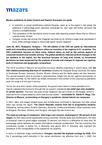
Mazars Central and Eastern European tax guide 2021
Mazars Central and Eastern European tax guide 2021
In a bid to best serve investors eying the region, Mazars’ CEE Tax Guide analyzes and summarizes tax changes in 21 countries and also points at prevalent trends and underlying strategies in taxation. In addition to the Visegrád Four, this year’s publication also includes the countries of South-East Europe, Russia, Ukraine, and the Baltic states. The 2021 survey puts spotlight on labor costs, indirect taxes, corporate income tax, and transfer pricing across the researched markets.
Although the pandemic has resulted in a number of changes in the tax systems of all countries in the region, the publication focuses on long-term trends, as it helps business leaders to make investment decisions by analyzing trends and changes in tax regimes relative to each other and previous years.
Highlights for 2021- Hungary
- The reduction of contributions has raised Hungary to the regional middle ground
- The domestic real-time data provision system has been completed, and the tax authority has access to all accounts
- In terms of the value of the minimum wage expressed in euros, we are in the last place among the Visegrad countries, the average wage in the private sector is stagnant
We hope and trust that our readers will find this summary useful and inspiring. We also included the contact information for Mazars offices and experts.
Download the guide in English by clicking the link below.
Please visit the interactive online platform of the Mazars CEE Tax Guide 2021:
Mazars Central and Eastern European tax guide 2021
Want to know more?



